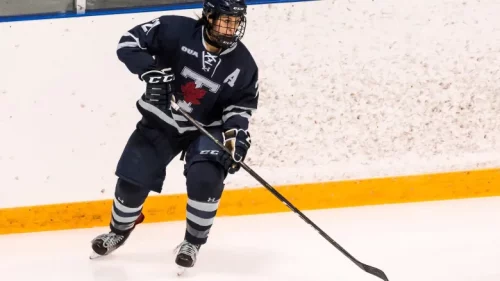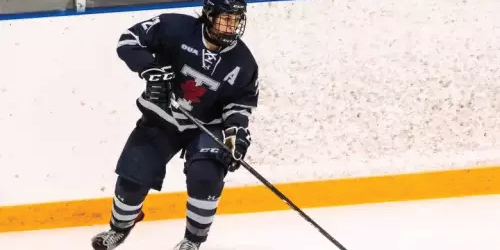Indigenous hockey program aims to grow friendships through inclusive sport environments

Despite the fact that hockey has traditionally been an expensive sport that lacks diversity, Jana Headrick is dedicated to creating positive experiences for Indigenous girls.
That’s why she founded a hockey program in the Greater Fredericton area on the traditional unceded territory of the Wolastoqiyik, Mi’kmaq and Peskotomuhkati peoples. She explains that to create positive experiences for Indigenous girls within sport, sport organizations must “help make them feel important and allow them to express themselves for who they are.”
Headrick and her supporters are trying to eliminate as many barriers as possible for children, especially children from the Black, Indigenous and People of Colour (BIPOC) community. She’s interested in designing and implementing programs specific to Indigenous girls and equity-deserving groups that allow them to create a space with other people who look like them.
Research has shown that BIPOC children, especially girls, face more significant sports barriers. Creating an inclusive and culturally diverse space for children will help them foster relationships and reap positive experiences. Her ultimate goal is for sport to be a positive experience that encourages a group of young Indigenous girls to get in the game and continue their sport pathway throughout the rest of their lives.
Headrick is a 23-year-old defenceman from Garden River raised in a hockey-loving Ojibway family. She has played sports, specifically hockey, since the age of three. Jana went on to play hockey at the University of Toronto for four years while pursuing her Bachelor’s degree in Kinesiology and Indigenous studies before moving on to play hockey for the University of New Brunswick, where she is working towards her Master’s degree in Sports and Recreation.
This past fall, she used her team’s resources, her coach’s expertise and most importantly, her love for the game to offer camps to Indigenous girls in the Fredericton area to make sure they got an opportunity to discover their passion.
“I just want to leave a lasting, positive impression on them for the game of hockey and try to make it as welcoming and safe a space as possible,” she said.
In her six-week program for Indigenous girls aged six to 10 in and around the Fredericton area, she focused on fundamental skill development such as skating and shooting while emphasizing fun.
Headrick said that more than anything, she wanted to “create a positive, inclusive space for the girls” since, for most of them, this was their first experience with hockey.
She came up with the idea of creating this program after getting the opportunity to meet with community members. In these meetings, Headrick and her teammates listened to the community members’ experiences in sport, which highlighted the need for the mainstream sports pathway to both recognize that participants might be on alternate pathways, and to provide opportunities for inclusion and access.
These meetings, combined with her lived experience as an Indigenous female athlete, contributed to her aspiration to eliminate as many barriers to sport as possible. For that reason, Headrick offered this camp free of cost and provided equipment free of cost to all the participants who needed it. On top of that, she provided the participants with the option to join a female minor hockey association free of cost after the program ended.
Thanks to the many generous supporters and stakeholders in the hockey community, she received the donations she needed to make her dream a reality and support Indegineous female athletes. She acknowledged that “within sport, everyone has their own types of traditions, but one thing that needs to happen is cultural awareness.”
She also reiterated that it doesn’t need to stop at cultural awareness. Coaches and sports stakeholders should be aware of the different backgrounds of people they may coach, whether they’re from diverse cultural backgrounds or members of the LGBTQ+ community. She’d like to see sport organizations work together to “help children feel important and be able to express themselves to create positive experiences both within and outside of sport.”
Headrick’s program is a prime example of the types of programs that are encouraged in the Indigenous Long–Term Participant Development Pathway. This pathway has grown out of the understanding that mainstream pathways for sport development do not necessarily align with Indigenous needs or experiences. As such, the Indigenous Long-Term Participant Development Pathway tries to address that gap by outlining the key elements that need to be considered when planning, developing, and implementing programs for and with Indigenous peoples and Indigenous communities.
Headrick’s contributions to sport were recognized in March 2022 at a USPORTS ceremony with the Marion Hilliard Award. This award is given annually to the student-athlete who best exhibits outstanding achievements in athletics, academics, and community involvement.
However, Headrick said that she is most grateful for all the support she’s received from her coach, teammates, and the community to have the opportunity to watch girls interact and help allow meaningful friendships to grow.
“There is no better feeling than watching friendships form and to see how much they were genuinely enjoying their hockey experience.”
Sport for Life’s Manager of People and Culture Billie Tes feels the program could serve as an example for other organizations and communities.
“At Sport for Life we are in a fortunate position to amplify the stories of BIPOC leaders in sport and physical activity. Headrick’s story is inspiring, especially as she maps out the pathway she took to provide culturally conscious sport experiences for girls in her community,” said Tes.
“There is so much learning that we can all gain from actually listening, sharing, and reflecting on our part in building inclusive sport environments.”

